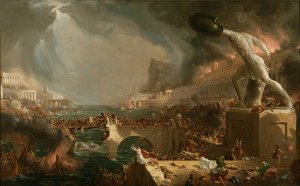Presented By: Classical Studies
Late Antiquity in Heavy Metal Music
Jeremy Swist, Visiting Assistant Professor of Classics, Grand Valley State University

One of the most prolific forms of the reception of the ancient world is the popular music genre of heavy metal. Hundreds of bands all over the world have contributed to a growing catalogue of thousands of songs, including dozens of concept albums, inspired by the history, mythology, philosophy, and art of the ancient Mediterranean. This phenomenon has increasingly drawn the attention of antiquity scholars working within the nascent field of metal music studies, who have noted how the genre’s predilection for themes of power, violence, monstrosity, liberation, and heritage make antiquity especially appealing for adaptation in music, lyrics, album artwork, music videos, stage performance, and merchandise. Most of this reception reflects that in popular culture, treating more familiar subjects like Medusa, Sparta, Alexander, Cleopatra, and Nero. Subjects from late antiquity appear less frequently—but the cases where they do are equally interesting and insightful, if not more so, into how profoundly metal artists can engage with both
primary and secondary sources for ancient political and religious history. These cases include concept albums on the tragic heroism of the emperor Julian and general Belisarius, songs glorifying Diocletian’s persecutions and condemning Constantine’s conversion, and cover artwork meant to depict the Visigothic sack of Rome. For heavy metal, late antiquity is where the romanticized past collides with the dystopian present.
Jeremy Swist is a Visiting Assistant Professor in the Department of Classics at Grand Valley State University, having previously taught at Miami University and Brandeis University. He earned his Ph.D. and MA in Classics from the University of Iowa, and BA in Latin and History from the University of Maine. His published research has explored the intersections of Greek and Latin rhetoric, philosophy, medicine, and historiography under the later Roman Empire, especially around the emperor Julian. Jeremy’s first monograph, titled Julian Augustus: Platonism, Myth, and the Refounding of Rome, will be published by Oxford University Press next year. He has also published on the prolific reception of ancient Greece, Rome, and Byzantium in heavy metal music, and is co-organizer of the biennial Heavy Metal and Global Premodernity online conference.
primary and secondary sources for ancient political and religious history. These cases include concept albums on the tragic heroism of the emperor Julian and general Belisarius, songs glorifying Diocletian’s persecutions and condemning Constantine’s conversion, and cover artwork meant to depict the Visigothic sack of Rome. For heavy metal, late antiquity is where the romanticized past collides with the dystopian present.
Jeremy Swist is a Visiting Assistant Professor in the Department of Classics at Grand Valley State University, having previously taught at Miami University and Brandeis University. He earned his Ph.D. and MA in Classics from the University of Iowa, and BA in Latin and History from the University of Maine. His published research has explored the intersections of Greek and Latin rhetoric, philosophy, medicine, and historiography under the later Roman Empire, especially around the emperor Julian. Jeremy’s first monograph, titled Julian Augustus: Platonism, Myth, and the Refounding of Rome, will be published by Oxford University Press next year. He has also published on the prolific reception of ancient Greece, Rome, and Byzantium in heavy metal music, and is co-organizer of the biennial Heavy Metal and Global Premodernity online conference.